
The Dyslexia Handbook is an essential resource — part two
This is the second in our series of posts about The Dyslexia Handbook
One of the most important resources for anyone associated with dyslexia, including parents, teachers and school administrators is a Dyslexia Handbook.
While not all states have them, dyslexia handbooks are a crucial resource to educators, administrators and parents. Of the more than 25 state handbooks that are in use, one of the most thorough is the one in Texas.
This 83-page booklet is available online and in print. First adopted in Texas in 1986, the Dyslexia Handbook is regularly updated by the State Board of Education. The latest update was made to the handbook in 2021.
For the primary content in the Texas Dyslexia Handbook, click here. Read on for highlights of the appendices in this important resource, which is one of the most frequently updated parts of the handbook.
Appendices to the The Dyslexia Handbook
Q & A: One of the most helpful sections of the Dyslexia Handbook is the question and answer section. With nearly 50 specific questions, this section covers a range of topics, including bilingual students, technology and state and federal law, as well as instruction, evaluation and teacher requirements. This section of the Dyslexia Handbook is the most recently updated, with a new version made available on March 18, 2022.
State Laws and Rules Related to Dyslexia: Texas State Law provides a host of accommodations and protections for neurodivergent children. This appendix is frequently updated as laws change and legislators utilize recent developments in best practices in an attempt to provide the best possible educational environment for children with dyslexia.
IDEA/Section 504 Side-by-Side Comparison: This section is particularly helpful, providing an in-depth comparison between the two regulations. Protections for children with dyslexia are much more extensive under the Individuals with Disabilities Education Act. While helpful to some students, section 504 of the Rehabilitation Act does not provide for Individualized Education Plans, which are crucial to ensuring that a student with dyslexia is able to reach their full potential.
Students with Disabilities Preparing for Postsecondary Education: As high school students prepare for their future, they and their families will have an array of questions about what college life will be like. This section answers many of those questions, including needed evaluations, available academic adjustments and protections for students with disabilities.
Contacts for Further Information: Texas is divided into 20 regions, each of which has a regional education service center and a dyslexia contact, who is available to help advocate for students with dyslexia and assist teachers and administrators. This appendix also includes contacts for organizations and university departments dedicated to assisting neurodivergent learners.
Associated Terms: Parents of students with dyslexia quickly realize that there is an array of terms and acronyms that they need to be familiar with in order to effectively advocate for their child. One of the most useful of the appendices is a glossary with dozens of entries related to dyslexia and the laws related to the condition.
This is just a few highlights of the research and resources available in the Texas dyslexia handbook, which is an indispensable resource for educators and families alike.
For more information about effective therapy for students with dyslexia, click here to schedule a consultation with Dyslexia on Demand.












